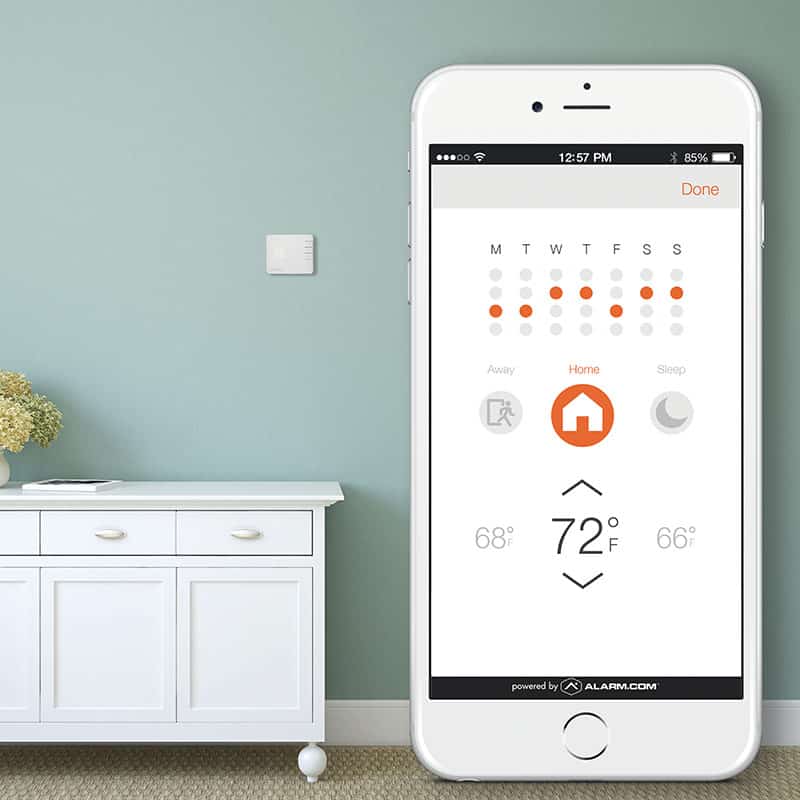
Smart home technology has brought a lot of new ideas and features to our lives. But while we often focus on the obvious gadgets, such as smart security cameras or voice activated lighting and so on, there has been advancement everywhere. Smart thermostats have been around for a while now, and the current options on the market offer a mature user experience with refined performance and features.
A thermostat may not be the most glamorous of technology, but it could be argued that smart thermostats have the potentially biggest impact of all smart tech. But as a piece of equipment, a smart thermostat doesn’t seem to be much different to a traditional one at first glance. Nothing could be further from the truth though. Smart thermostats really can change your heating and cooling systems forever, here’s how.
A smart thermostat?
To understand what a smart thermostat can do for your home or workplace, and why it really should be your next home purchase, we need to understand what a smart thermostat is. Today there are many brands on the market, and they all provide a variety of features and ideas, but at their heart, all smart thermostats work the same way.
A smart thermostat is not just a single temperature sensor that regulates your heating and cooling systems, as a traditional style would be. It is a connected device that can take input from any number of smart devices in your home. The most common way of taking advantage of this is to set up several smart temperature sensors around the property, but it could be connected to a smart security system, work in tandem with the central smart controller to heat and cool specific areas of the home at different times and so on.
How does that help?
Traditional heating and cooling systems are a one-shot thing, you set a temperature on the thermostat, and it controls the heating or air conditioner to maintain that temperature at that location. The problem is, the rest of the property may be warmer or cooler than that specific location, but the same heat or cooling is applied to those too.
With a smart thermostat, the system is aware of temperatures all over the property, and it adjusts each area individually to maintain the temperature required. This approach is proven to save energy, and as a result money, for bigger properties and commercial installations, those savings can be significant.
Smarter heating and cooling
That ability is just the starting point. Smart thermostats can take inputs from other smart devices too. In tandem with your security system, it can detect when you leave the property and later return, and then adjust the heating and cooling to save energy while you are away. In a commercial environment, this could be applied to specific areas of the property, only heating or cooling when in use. Some smart thermostats can even detect when a window is open, and then shut down or minimize heating or cooling in that area to avoid wasting huge amounts of energy.
In combination with an app, many smart thermostats also feature GPS based location monitoring. They know when you are approaching the property and alter the settings to provide a comfortable temperature when you get home. With this kind of flexibility, the heating and cooling systems save energy, reducing running costs and minimizing maintenance requirements.
A user-friendly approach
New technology is great, and as we have discussed, the idea of a smart thermostat reacting to your needs and saving energy is an attractive one. But if it is complex and difficult to set up, then that is a technology that will never really get to mainstream use. Smart thermostats are actually very easy to use, in fact, most are probably easier to set up than a traditional solution.
In most cases, the smart thermostats package includes an app to use on a smartphone to control everything. Even setting up the more technical features is a simple process thanks to visual interfaces and clear guides at every stage.
Heating to suit, wherever you are
The use of an app brings in even more functionality. Who hasn’t sat awake on the first night of a holiday trying to remember if you turned the heating off, or set it too low? Now there is an answer. Because everything is connected to your home network, wherever you are, your smartphone app can sign into your smart thermostat, see the current settings and even make changes if you want.
This is useful for business too. Think about this, the temperature rapidly drops, and an unexpected snowfall begins at 11 in the evening. With an app, you can turn up the heating at your business premises, protecting goods and preventing frozen pipes, all without leaving home. The same can be done with air conditioning, adjusting to suit from wherever you happen to be.
Less Energy, More Control
A common theme with all these features is that they help reduce energy use. From only heating or cooling the areas you are using to recognizing the property is empty and turning the system down as a result, a smart thermostat is constantly minimizing the energy required to provide the heating and cooling you need.
That means lower costs of course, but it is also an environmentally sound approach. That is great for the environment, it is also beneficial to businesses, where carbon footprint is an increasingly important aspect of brand value.
It is not often that a new piece of technology improves performance and reduces running costs at the same time, but that is exactly what a smart thermostat can do. It is easy to gloss over this part when looking at the individual features, but the reality is a smart thermostat gives you more, for less.
The user-friendly approach, flexible heating and cooling performance and other additions all make a smart thermostat worthwhile too, and it can create a smart home environment that is more comfortable, more of the time. As a home or business owner, less energy use, and the benefits to running costs and the environment that brings, are why a smart thermostat should be found in every property today.


